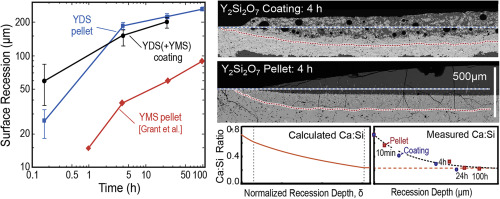当前位置:
X-MOL 学术
›
Acta Mater.
›
论文详情
Our official English website, www.x-mol.net, welcomes your feedback! (Note: you will need to create a separate account there.)
Interaction of yttrium disilicate environmental barrier coatings with calcium-magnesium-iron alumino-silicate melts
Acta Materialia ( IF 9.4 ) Pub Date : 2018-02-01 , DOI: 10.1016/j.actamat.2017.12.004 David L. Poerschke , John H. Shaw , Nisha Verma , Frank W. Zok , Carlos G. Levi
Acta Materialia ( IF 9.4 ) Pub Date : 2018-02-01 , DOI: 10.1016/j.actamat.2017.12.004 David L. Poerschke , John H. Shaw , Nisha Verma , Frank W. Zok , Carlos G. Levi

|
Abstract Reactions between molten calcium-magnesium-iron alumino-silicate (CMFAS) deposits and yttrium disilicate (Y2Si2O7, YDS) based environmental barrier coatings (EBC) on SiC/SiC ceramic matrix composites (CMCs) were investigated at 1300 °C. The coating readily dissolves into the melt from which an apatite phase, nominally Ca2Y8(SiO4)6O2, precipitates. These reactions are sufficiently fast to consume the majority of the approximately 275 μm thick coating in 24 h. Liquid phase separation, producing an essentially pure SiO2 second phase, occurs near the reaction front suggesting dissimilar rates of CaO and SiO2 exchange with the overlaying deposit. The rise of large bubbles through the melt above the coatings appears to disrupt the reaction layer and distributes apatite throughout the residual deposit. Channel cracks were found in the deposits and the reaction layers; after longer exposures, the cracks branch and extend laterally through the Si bond coat and into the underlying CMC. Complementary experiments performed on monolithic YDS pellets yielded long-term recession rates similar to those of the coatings, although some differences were evident in recession rates and reaction layer morphologies in the early stages. Thermodynamic calculations were used to understand the evolving driving force for the YDS-to-apatite conversion. The agreement between the simulated and experimentally observed behaviors suggests that such calculations could be used to predict the influence of temperature and deposit composition on EBC degradation.
中文翻译:

二硅酸钇环境屏障涂层与钙镁铁铝硅酸盐熔体的相互作用
摘要 研究了熔融钙镁铁铝硅酸盐 (CMFAS) 沉积物与二硅酸钇 (Y2Si2O7, YDS) 基环境阻隔涂层 (EBC) 在 SiC/SiC 陶瓷基复合材料 (CMC) 上在 1300 °C 下的反应。涂层很容易溶解到熔体中,从中析出磷灰石相,名义上是 Ca2Y8(SiO4)6O2。这些反应足够快,可以在 24 小时内消耗掉大部分约 275 μm 厚的涂层。液相分离,产生基本上纯的 SiO2 第二相,发生在反应前沿附近,表明 CaO 和 SiO2 与覆盖沉积物的交换速率不同。大气泡通过涂层上方的熔体上升似乎破坏了反应层并使磷灰石分布在整个残留沉积物中。在沉积物和反应层中发现通道裂纹;长时间曝光后,裂纹分支并横向延伸穿过 Si 键合层并进入下面的 CMC。对整体 YDS 颗粒进行的补充实验产生了与涂层相似的长期衰退率,尽管早期阶段的衰退率和反应层形态存在一些明显差异。热力学计算用于了解 YDS 到磷灰石转化的演变驱动力。模拟行为和实验观察行为之间的一致性表明,此类计算可用于预测温度和沉积物成分对 EBC 降解的影响。裂纹分支并横向延伸穿过 Si 键合涂层并进入下面的 CMC。对整体 YDS 颗粒进行的补充实验产生了与涂层相似的长期衰退率,尽管早期阶段的衰退率和反应层形态存在一些明显差异。热力学计算用于了解 YDS 到磷灰石转化的演变驱动力。模拟行为和实验观察行为之间的一致性表明,此类计算可用于预测温度和沉积物成分对 EBC 降解的影响。裂纹分支并横向延伸穿过 Si 键合涂层并进入下面的 CMC。对整体 YDS 颗粒进行的补充实验产生了与涂层相似的长期衰退率,尽管早期阶段的衰退率和反应层形态存在一些明显差异。热力学计算用于了解 YDS 到磷灰石转化的演变驱动力。模拟行为和实验观察行为之间的一致性表明,此类计算可用于预测温度和沉积物成分对 EBC 降解的影响。尽管早期阶段的衰退率和反应层形态存在明显差异。热力学计算用于了解 YDS 到磷灰石转化的演变驱动力。模拟行为和实验观察行为之间的一致性表明,此类计算可用于预测温度和沉积物成分对 EBC 降解的影响。尽管早期阶段在衰退率和反应层形态方面存在明显差异。热力学计算用于了解 YDS 到磷灰石转化的演变驱动力。模拟行为和实验观察行为之间的一致性表明,此类计算可用于预测温度和沉积物成分对 EBC 降解的影响。
更新日期:2018-02-01
中文翻译:

二硅酸钇环境屏障涂层与钙镁铁铝硅酸盐熔体的相互作用
摘要 研究了熔融钙镁铁铝硅酸盐 (CMFAS) 沉积物与二硅酸钇 (Y2Si2O7, YDS) 基环境阻隔涂层 (EBC) 在 SiC/SiC 陶瓷基复合材料 (CMC) 上在 1300 °C 下的反应。涂层很容易溶解到熔体中,从中析出磷灰石相,名义上是 Ca2Y8(SiO4)6O2。这些反应足够快,可以在 24 小时内消耗掉大部分约 275 μm 厚的涂层。液相分离,产生基本上纯的 SiO2 第二相,发生在反应前沿附近,表明 CaO 和 SiO2 与覆盖沉积物的交换速率不同。大气泡通过涂层上方的熔体上升似乎破坏了反应层并使磷灰石分布在整个残留沉积物中。在沉积物和反应层中发现通道裂纹;长时间曝光后,裂纹分支并横向延伸穿过 Si 键合层并进入下面的 CMC。对整体 YDS 颗粒进行的补充实验产生了与涂层相似的长期衰退率,尽管早期阶段的衰退率和反应层形态存在一些明显差异。热力学计算用于了解 YDS 到磷灰石转化的演变驱动力。模拟行为和实验观察行为之间的一致性表明,此类计算可用于预测温度和沉积物成分对 EBC 降解的影响。裂纹分支并横向延伸穿过 Si 键合涂层并进入下面的 CMC。对整体 YDS 颗粒进行的补充实验产生了与涂层相似的长期衰退率,尽管早期阶段的衰退率和反应层形态存在一些明显差异。热力学计算用于了解 YDS 到磷灰石转化的演变驱动力。模拟行为和实验观察行为之间的一致性表明,此类计算可用于预测温度和沉积物成分对 EBC 降解的影响。裂纹分支并横向延伸穿过 Si 键合涂层并进入下面的 CMC。对整体 YDS 颗粒进行的补充实验产生了与涂层相似的长期衰退率,尽管早期阶段的衰退率和反应层形态存在一些明显差异。热力学计算用于了解 YDS 到磷灰石转化的演变驱动力。模拟行为和实验观察行为之间的一致性表明,此类计算可用于预测温度和沉积物成分对 EBC 降解的影响。尽管早期阶段的衰退率和反应层形态存在明显差异。热力学计算用于了解 YDS 到磷灰石转化的演变驱动力。模拟行为和实验观察行为之间的一致性表明,此类计算可用于预测温度和沉积物成分对 EBC 降解的影响。尽管早期阶段在衰退率和反应层形态方面存在明显差异。热力学计算用于了解 YDS 到磷灰石转化的演变驱动力。模拟行为和实验观察行为之间的一致性表明,此类计算可用于预测温度和沉积物成分对 EBC 降解的影响。


























 京公网安备 11010802027423号
京公网安备 11010802027423号